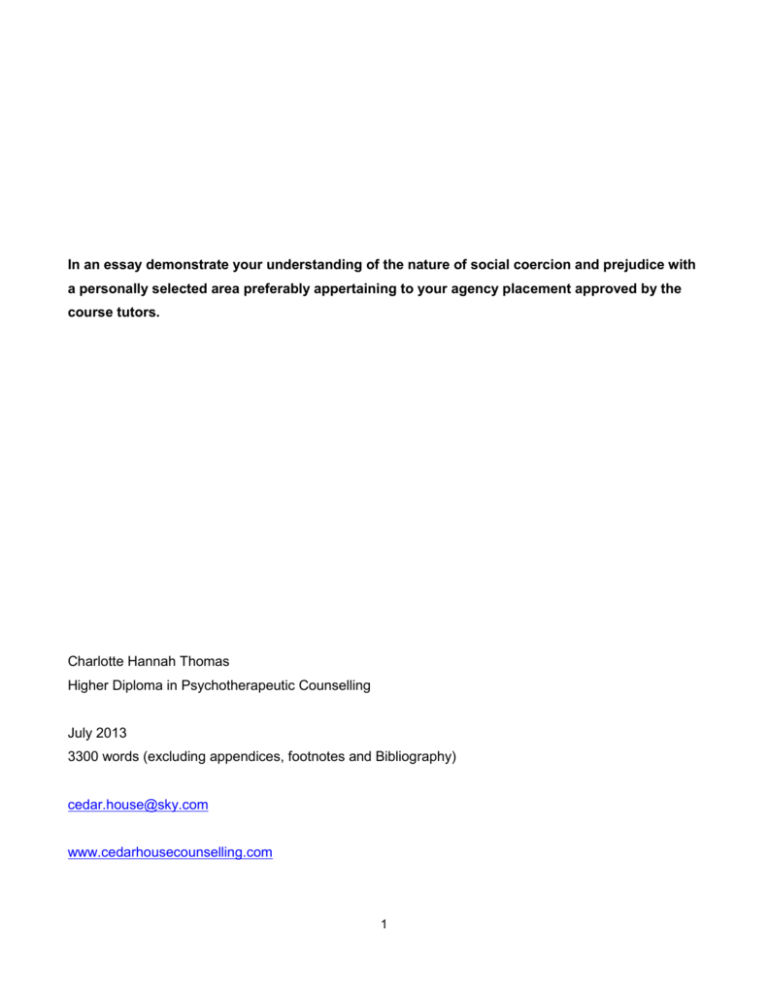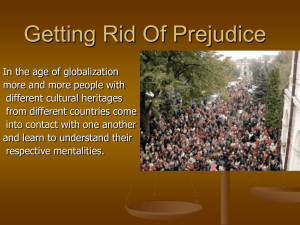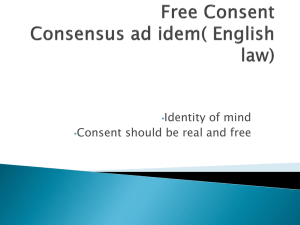Working with older adults
advertisement

In an essay demonstrate your understanding of the nature of social coercion and prejudice with a personally selected area preferably appertaining to your agency placement approved by the course tutors. Charlotte Hannah Thomas Higher Diploma in Psychotherapeutic Counselling July 2013 3300 words (excluding appendices, footnotes and Bibliography) cedar.house@sky.com www.cedarhousecounselling.com 1 Aims and objectives The aims and objectives of this assignment are to: Demonstrate an understanding of the nature of social coercion Demonstrate an understanding of the nature of prejudice Explore how social coercion and prejudice impact on our work with older adults in the Agency Exploring how social coercion and prejudice impact on work with older adults in the Agency1 ~ A vignette from Group Supervision, Friday 21 June 2013 ~ Evie, a student counsellor, had recently joined the supervision group and had been given the agency’s 2 assessment report for her first client. She read aloud to the group from the report: ‘He is called Ted and he is 73 years old………….’ ‘….an older client,’ our psychodynamic Supervisor observed, ‘and a male one to boot. A rarity…….’ she said, with growing interest, ‘we have so few…’ ‘Yes,’ Evie continued, ‘I spoke to his wife on the ‘phone and she is going to drive him here because he is not very mobile and he uses a wheelchair, ahh…‘, she said, ’poor thing…’ Hearing this, the Supervisor’s expression changed and she snapped at Evie: ‘I am 82 next week and I certainly don’t want any pity from trainee Counsellors………..’ 1 In exploring these topics there is no intended criticism of the Agency or of any individual associated with the Agency. The Agency is a registered charity accredited by the BACP, offering short and open-ended counselling to individual clients based locally. Group supervision takes place fortnightly and counsellors are all volunteers, either qualified or in training. Clients will self-refer to the Centre or will come having been placed on the waiting list for counsellling through the NHS by their General Practitioner. 2 In addition, as an additional precaution, to protect the reputation of those involved, the Agency is not identified in this assignment and the names of the counsellors and clients have all been changed. 2 The group was silent for a moment and then, Violet, an Integrative counsellor, ‘rescued’ the situation and the group agreed to use some time during their next session to explore and understand: their own beliefs, experience and feelings about ageing, the ageing population and ageism how this had impacted on their work with older adults at the agency The nature of social coercion The goal of coercion is compliance and so the aim of ‘social coercion’ is usually to force a group or an individual to comply with the ‘norms’ or the will of a particular society. Coercion is linked to the notion of involuntary thought, and invariably involves the use of violence, force or compulsion. Coercion is also associated with emotional manipulation, interpersonal infringement and the violation of an individual right. Those who coerce seek to justify it by suggesting that society cannot function without some form of ‘authorised’ uses of coercion to ensure cooperation and peaceable coexistence. For example Anderson says: ‘It helps keep the bloody minded and recalcitrant from harming others, and seems to be an indispensable technique in the rearing of children.’ (Anderson 2011) ‘Coercion’ is the term often used to describe behavior involved in government by a dictatorship, where that government is imposed and against the will of the majority. It is not usually used to describe democratically elected governments, but the concept is subjective and in some circumstances social coercion can be used to create what appears to be a mandate for a political ideology, the obvious examples of this are Nazi Germany and the fictional regime of George Orwell’s 1984. Coercion places a limit on freedom, on the capacity to choose an action or belief or on the number of options available from which to choose. ‘Social coercion’ differs from ‘social influence’ in that the former is invariably associated with control and may involve a ‘threat’ or ‘offer’ of something in return for compliance. For example, do ‘A’ and you will get ‘B’, or do ‘A’ and you will be free from ‘C’. Social influence, on the other hand, or ‘socialisation’ is a concept that may be used to describe more gentle and subtle social pressures, without necessarily involving the use of force. It is often about the need to conform to peer expectations, parental pressures and social norms, such as acting in a way that is thought to be appropriate for a particular age group. 3 Social influence might involve campaigning and advertising and socialisation, if looked at through the lens of Transactional Analysis, would include the setting of boundaries by the ‘controlling’ or ‘nurturing parent’ in the development of the ‘adapted’ rather than the ‘free’ child. Social influence and ‘spin’ are often used in social planning to describe the act of influencing others to adopt a particular set of beliefs or behaviors. At the moment, politicians in this country, refer frequently to ‘hard working families’ in order to suggest, in an indirect way, that those who do not work are less deserving. The desired behaviour is often presented as in the collective interests of those involved and examples include eating ‘5 a day’, helping to conserve the planet’s resources and, in some societies, limiting family size or favouring male offspring. The nature of prejudice Prejudice involves holding a preconceived preference, idea or conviction that is unreasonable and not informed by the facts of the case. It is an unfounded belief or pre-judgment that is resistant to rational influence. Prejudice refers to attitudes, while discrimination focuses on behavior. The term is popularly used now to refer to preconceived, usually unfavorable, judgments towards a person or people because of their gender, age, disability, faith, sexuality and race/ethnicity or other personal characteristics. When used in this way prejudice refers to a positive or negative evaluation of another person based on their group membership and may be based on suspicion or hatred of a particular group. The definition of ‘ageism’ that has become most widely accepted is: ‘prejudice and discrimination against older people based on the belief that ageing makes people less attractive, intelligent, sexual, and productive’. Nelson (2004) Linked to prejudice is the idea of the ‘stereotype’. Stereotypes are cognitive structures through which people store beliefs and expectations about the characteristics of members of social groups. Cuddy (2002) explains that: ‘Stereotypes develop over time as people perceive their changing environments, interpret the perceived information, and encode it in memory. Biased by various cognitive processes, these collections of beliefs are later retrieved for use in interpreting social cues, and consequently directing how we behave in social interactions.’ (p4) 4 Stereotypes and prejudice arise from this automatic and rather static categorisation, storage and recall system and in many cases the system will be inaccurate and out-of-date. Cuddy goes on to say: ‘Accurate or not, stereotypes guide our social behavior and often govern what information we seek, need and remember. At the root of stereotyping is our impulse to assign objects, events, and people to meaningful classes, about which we have established beliefs and expectations.’ (p4) Ageism The Supervisor said that she felt a bit like Freud in feeling like ‘old’ was always the age just above one’s own. At just 49, Freud dismissed the over-50s on the grounds that: ‘the elasticity of mental processes, on which the treatment depends is, as a rule lacking – old people are no longer educable.’ Freud (1905). But seriously, she said, considering oneself, or our clients, as ‘old’ or ‘too old’ could lead to self-limiting beliefs such as that: depression is a natural consequence of being old and is almost ‘justifiable’, ‘normal’ or untreatable, resulting in ‘therapeutic nihilism’ and limited expectations of treatment from both the client and health care professional it is a time for noticing only the deficits: failing health, loss of (work related) status and identity, loss of family (the empty nest) and the death of friends and loved ones it is time to withdraw from life it is ‘too late’ for therapy ‘I would prefer’, she said, ‘to use a development perspective like Erikson’s The Life Cycle Completed (1998) that culminates in: ‘Transcendence in the face of imposed withdrawal…’. 5 Of course, the Agency has no upper age limit for clients and has comprehensive operational policies to promote equality of opportunity. But historic concepts about ‘withdrawal’ and an over emphasis on youth in the collective consciousness, create barriers and serve to encourage older adults to become invisible in society. Perceptions of how older people are portrayed in the media are depicted in the attached ‘Wordle’ taken from the research into age stereotypes conducted on behalf of the Australian High Commission in 2013 (appendix 1). ‘While age is a biological fact, attitudes and behaviours towards people based on their chronological age are socially determined. Age is used to categorise people and serves as a proxy for expected abilities, competence, skills, experience and even health status’. (Wilkinson and Ferraro 2002 p 32) The Supervisor insisted that: ‘Everyone ages differently, which is why it is so important that we offer accurately focused attention and give counselling responses based on the needs of the individual.’ Violet agreed and said that this approach was entirely consistent with offering the ‘core conditions’3 and using the Person Centred model. She said that she has successfully used a range of approaches with older clients including Cognitive Behavioural Therapy to focus on negative thoughts about age and their reinforcing behaviours. She said that she did not see the need to match older clients to work with older therapists and that in doing so we were also making unwarranted and prejudicial assumptions about our clients and our therapists. Depending on the needs of the client she said, she had approached the work with reference to the four later life development tasks identified by Hildebrand (1990) and King (1974) and presented by Murphy (2000) (appendix 2). She added that Mind’s ‘Access all ages’ campaign sets out some legitimate expectations for later life and that perhaps these expectations should be adopted by the Agency (appendix 3). 3 Rogers stated that there are six necessary and sufficient conditions required for therapeutic change: Psychological Contact, Client’s incongruence, Therapist’s congruence, Therapist’s Unconditional Positive Regard, Therapist’s Empathy and the Client’s Perception that the conditions are present. 6 She also referred to the Ethical Framework of the British Association for Counselling and Psychotherapy (BACP) which demands fair and impartial treatment that is appropriate to the needs of all clients. She said that, as practitioners, we must continually examine our own beliefs about age and make every effort to guard against limiting our expectations for the client as a result of our own agerelated prejudice. The Code says: ‘Practitioners should not allow their professional relationships with clients to be prejudiced by any personal view they may hold about lifestyle, gender, age, disability, race, sexual orientation, beliefs or culture.’ (page 6, para 19). This view is supported by Yvonne Craig (1997) who said: ‘it helps us to avoid polarizing people, and being influenced ideologically by current social attitudes to those of us in later life, whether we are considered as nice old dears, or as selfish and senile consumers of the social and health services.’ (p26) Evie joined the discussion and said that she found it really difficult not to absorb the negative ‘ageism’ that permeates all aspects of our society because they are so prevalent and, she said, almost socially condoned. She said that she had reflected on how, when she first read the assessment report, she almost ‘infantilised’ Ted and now she has become acutely aware of that awful tone of voice that some health care professional adopt with older patients as if they were talking to a child: ‘are we ready for our bath now my love?’ She said that she has learnt a great deal from the supervision group about respect, human rights and dignity and ensuring integrity in the practitioner-client relationship. In his discussion of the origins of Ageism (2004) Nelson observes that: ‘One of the unique features of ageism is that age, unlike race and sex, represents a category in which most people from the in-group (the young) will eventually (if they are fortunate) become a member of the out-group (older persons). Thus, it seems strange that young people would be prejudiced toward a group to which they will eventually belong.’ 7 Evie went further and said that she believed, like Susan Fiske (2013), that there was evidence that our ageist stereotypes have ceased to be merely ‘descriptive’ – ‘describing what older people allegedly are,’ to ‘prescriptive’ stereotypes that ‘attempt to control how older people should be.’ She said that we may be witnessing a shift from prejudice (which was bad enough) to something more akin to ‘social coercion’. Evie said that work of Susan Fiske was discussed at a meeting of the Association for Psychological Science in May 2013 and subsequently described by Wray Herbert in the Huffington Post as ‘The New (Malevolent) Ageism’. She explained that the continual focus on an ageing population and the statistics that predict the proportion of us who will be over 65 4 in the future, suggested that older people will, or have already become, perceived as either a burden on health and public services or an economic threat. Similarly, research from KPMG, reported by Churchard in the People Management Magazine (July 2013), warns about ‘Age Warfare’ and a growing resentment in the competition for too few jobs as older people remain in the workforce for longer. Fiske identifies three new stereotypes that she believes will be fueled by ‘scarcity’: jobs and succession – older adults remaining in work (the statutory retirement age having been abolished in the UK) not making way for younger people to move into the workforce. Competition for jobs and wealth will intensify as older workers delay retirement, often out of financial necessity, sometimes indefinitely a burden on the states resources – social security benefits/pensions and health and social care. Fewer people in work and contributing through taxes and more people drawing on support young people will increasingly enforce generational boundaries and societal norms so that, as older adults reinvent old age by staying healthy and active and acting young, the youth will admonish them to ‘act your own age’ in a backlash against older adults. 4 Among the countries currently classified by the United Nations as more developed (with a total population of 1.2 billion in 2005), the overall median age rose from 29.0 in 1950 to 37.3 in 2000, and is forecast to rise to 45.5 by 2050. The corresponding figures for the world as a whole are 23.9 in 1950, 26.8 in 2000, and 37.8 in 2050. In Japan, in 1950 there were 9.3 people under 20 for every person over 65. By 2025 this ratio is forecast to be 0.59 people under 20 for every person over 65. (United Nations 2004) 8 Fiske predicts that younger people will become punitive against the violators of ageist social norms and more rewarding toward older people who comply with ageist stereotypes. Whilst, at this time, these remain largely just predictions of impending social pressures, Fiske has already presented some preliminary evidence to suggest that these new stereotypes are taking hold in America. (North and Fiske 2013). As they consider the consequences of these predictions, the supervision group reflects on how these new stereotypes might impact on their work with older adults in the Agency. The final counsellor in the group, who has not yet spoken, refers to the emphasis that the BACP Ethical Framework places on ‘Autonomy’ and a ‘respect for the client’s right to be self-governing’. The principle of Autonomy, she says, is directly opposed to manipulation, coercion and social pressure and we must, as counsellors, be alert to these stereotypes, which may be elusive and subtle, but may have a corrosive impact. She says she has been reading, with interest, the recent Mental Health Foundation report ‘Getting on… with life’, a review of ‘ageing well’ focusing on the so-called ‘Baby Boomer’ generation, a cohort of which she is a part. She says that this review comments on government policy which ‘fixates on agerelated decline’ and the growing ageing population and says that: ‘Current economic and political language often refers to the challenges this presents, in particular in relation to the costs of supporting large numbers of older people. This report joins many calls to treat increased human longevity as a success, recognising and promoting the social and economic contribution older people make.’ (Grant 2013 p14) The counsellor says that this is important because, as the report says, these negative attitudes: ‘…can contribute to feelings of worthlessness and despair and reduces mental health by undermining personal self esteem, putting people at risk of mental illness….’. Grant (2013). She said that she has also read an interesting Therapy Today article written in 2008 by Eleanor Patrick entitled ‘Older, wiser and unlikely to be present’. The article discusses the lack of training for counsellors for their work with older clients and the lack of health care resources available for older adults. Patrick also draws a comparison between two main and mostly opposing views of ageing and the psychological treatment plans that would follow. 9 The first view is about endless losses – retirement, reduced social engagement, failing health, dependence, dementia and disability. The treatment plan is all about coming to terms with loss. The second view is about older people becoming a mature resource with a wealth of observations about life and how humans behave and interact. The treatment plan here is to use the maturity of older clients as a source of strength and use this to cope with the challenges of later life. The counsellor continued and said that, despite the ageing population, we have disproportionately low numbers of older clients coming to, or being referred to the Agency. This is the case despite research conducted by Levy et al (2002) that has shown that older people with more positive self-perceptions live 7.5 years longer than those with more negative ones. The counsellor informed the group that the Agency Director had just secured some additional local authority funding for our work with older clients and suggested that we discuss how we could attract more of these clients and avoid our own ‘psychological defences’. The supervisor laughed and said; as I am psychodynamic I claim psychological defences as my territory! She explained that there is a view that the client’s age can be an important factor in the nature of the transference and that therapists themselves may struggle to acknowledge the infantile needs of an older client because of an unconscious fear of their own perceived dependence as they grow older, or they may have unconscious concerns about the needs of an older family member. But, she said, this is unlikely to be the main reason why older people are significantly under-represented in this Agency and as users of talking therapies in general. She said that there were fewer referrals from GPs, low expectations of treatment and stigma around mental health issues, ‘being on medication’ and seeking help. Eleanor Patrick (2008) says: ‘Of course many over-60s are out conquering the world with the children’s inheritance – possibly escaping from, or accompanied by, their unresolved issues. But others present possible problems for traditional counselling services: mobility, 50-minute fatigue, faltering concentration, deafness and physical illness.’ The counsellor says that she feels that they should do more to encourage older people to consider therapy and suggested a range of options such as: better contact with GPs and awareness raising through other services. 10 The charity Age UK has been campaigning on the issue of older people and their access to services for depression and they say: ‘More than two million of us over 65 suffer from depression. But because of our age, many of us don’t receive the help we need. Doctors struggle to spot the signs of depression, and those who do are constrained by the narrow range of treatments available on the NHS. The NHS is failing us, so we receive worse care than younger people with depression. We want the NHS to see us as people; see our needs and not just our age. We want help to get better.’ The Supervisor said that we were coming to the end of the session and she wanted to finish with an extract from an excellent and very encouraging Age UK factsheet called ‘Down, but not out’ written by Judith Brech. ‘Psychotherapy can be particularly valuable in the second half of life. Existing coping strategies and lifestyles may have become less effective as a result of the natural changes associated with getting older. Psychotherapy can help access underlying potential and creativity which enable a more positive adaptation to changing circumstances.’ Summary The Supervisor thanked the group for a fascinating discussion and said that she would like to conclude with a short summary. She said we have explored the nature of prejudice and social coercion and how they impact on our work with older adults in this agency. We have identified self-limiting beliefs, how age is used to categorise people and how ‘ageism’ restricts the access older people have to therapy despite the fact that the Agency has no upper age limits for therapy. As therapists, we will continue striving to avoid the ‘descriptive’ ageist stereotypes with which we are all familiar, and to be alert to any new ‘prescriptive’ ones that seek to control how older people should think and behave. We are conscious of the negative impact of the current political debate that characterises the ageing population as either a ‘threat’ or a ‘burden’ on society rather than a valuable asset. And finally, we have recognised the contribution that talking therapies can make in helping older adults deal with the challenges they face; whether they see later life overall as a series of losses or the source of greater maturity. 11 Appendix 1 Perceptions of how older people are portrayed in the media The size of each word is directly proportionate to the number of mentions of that theme in response to the question. ‘Thinking about everything you see and hear in the media (including on TV, online, on the radio and in newspapers and magazines), how does the media portray older people Fact or fiction? Stereotypes of older Australians Australian Human Rights Commission 20135 http://www.humanrights.gov.au/sites/default/files/document/publication/Fact%20or%20Fiction_2013_W ebVersion_FINAL_0.pdf 5 12 Appendix 2 Typical later life developmental tasks have been derived by Hildebrand (1990) from King (1974). a. The threat of redundancy or displacement in work roles by younger people and awareness of the possible failure of effectiveness of professional skills. This is linked with anxieties about managing retirement, with a feared loss of self-worth and identity with the loss of professional or work roles. This involves recognition that what can now be achieved in life may be limited, with resultant feelings of depression and deprivation. b. The need to re-examine and remake relationships after children leave home and can no longer be used to mask difficulties in the relationship. This will include the impact on the relationship of the fear of the diminution or loss of sexual potency and the potential loss of a partner with the associated intimacy and identifications. c. Recognition that one might have failed as a parent and the impact of this on one's children, with a consequent loss of perpetuating aspects of the self if children do not recognise or identify with these. d. The awareness of one's own ageing with possible illness and consequent dependency and the fact of one's own death and its associated narcissistic and object-related loss and pain. Murphy, S. (2000) Provision of Psychotherapy Services for Older People. Psychiatric Bulletin (2000) 24: 181 – 184. http://pb.rcpsych.org/content/24/5/181.full 13 Appendix 3 Mind’s Access all Ages Campaign For too long, the mental health needs of people in later life have been neglected and misrepresented. In later life we should be able to expect: to be treated with equal respect to have access to the same level and quality of support and treatment as other age groups to be supported by professionals who have expertise and training in mental ill health to be offered a choice of treatments to be given sufficient appropriate information in order to make an informed choice to be fully involved in planning, monitoring and reviewing any care needed. Today, for many older people, these are false expectations 14 Bibliography Abrams, D, Age UK (2011) A Snapshot of Ageism in the UK and across Europe. European Group on Attidues to Age, University of Kent. http://www.ageuk.org.uk/documents/en-gb/forprofessionals/equality-and-humanrights/snapshot%20of%20ageism%20in%20europe_pro.pdf?dtrk=true first accessed on 24 June 2013 Anderson, S, (2011) Stanford Encyclopedia of Philosophy. Available through http://plato.stanford.edu/entries/coercion/ first accessed 20 June 2013 Australian Human Rights Commission (2010) Age Discrimination – Exposing the Hidden Barrier for Mature Age Workers http://cache-au.funnelback.com/search/cache.cgi?collection=fed-gov&doc=funnelback-webcrawl.warc&off=1068355531&len=4736&url=https%3A%2F%2Fwww.humanrights.gov.au%2Fsites%2F default%2Ffiles%2Fpubform.doc first accessed 20 June 2013 Fact or fiction? Stereotypes of older Australians (2013) Australian Human Rights Commission 2013 http://www.humanrights.gov.au/sites/default/files/document/publication/Fact%20or%20Fiction_2013_W ebVersion_FINAL_0.pdf first accessed 20 June 2013 Brech, J. Down, but not out factsheet: Counselling and Psychotherapy. Age UK http://www.ageuk.org.uk/Documents/EN-GB/Counselling_and_psychotherapy_fcs.pdf?dtrk=true first accessed 26 June 2013 British Association for Counselling and Psychotherapy (revised edition 2007) Ethical Framework for Good Practice in Counselling and Psychotherapy. www.bacp.co.uk Burroughts, H., Lovell, K., Morley, M., Baldwin, R., Burns, A. and Chew-Graham, C. (2006) Family Practice 2006; 23: 369 – 377. ‘Justifiable depression’: how primary care professionals and patients view late-life depression? A qualitative study http://fampra.oxfordjournals.org/ first accessed on June 26 2013 15 Churchard, C. (2013) ‘Age Warfare’, the new threat to workforce productivity. Research reveals growing tension between the generations. People Management Magazine. http://www.cipd.co.uk/pm/peoplemanagment/b/weblog/archive/2013/07/01/age-warfare first accessed 2 July 2013 Craig, Y. (1997) Attitudes to Ageing: Its social construction, deconstruction and reconstruction In the BACP Counselling Reader Volume Two published in 2001 by Sage Publications in Association with British Association for Counselling and Psychotherapy Ltd. London Cuddy. A, J, C, and Fiske, S, T. (2002) Doddering but Dear: Process, Content, and Function in Sterotyping of Older Persons in Stereotyping and prejudice against older persons edited by Nelson, T,D. 2004 Massachusetts Institute of Technology Devlin, K, (2013) Over 65s not being treated for depression ‘because of ageism’, says Age Concern in http://www.telegraph.co.uk/news/2540278/Over-65s-not-being-treated-for-depression-because-ofageism-says-Age-Concern.html first accessed on 26 June 2013 Erik, E., and Erikson, J. (1998) The Life Cycle Completed. Extended Version W.W. Norton and Company. New York – London. Freud, S. (1905) On psychotherapy. Reprinted (1953 – 1974) in the Standard Edition of the Complete Works of Sigmund Freud (trans. & ed. J. Strachey), vol. 7. London: Hogarth Press. Grant, J (2013) Getting on ….with life. Baby boomers mental health and ageing well. A review. Mental Health Foundation http://www.mentalhealth.org.uk/publications/getting-on-full-report/ first accessed 20 June 2013 Hafford-Letchfield, T, (2011) Older People need Counselling too! http://www.infonet-ae.eu/en/articles/older-people-need-counselling-too-1206 first accessed on 26 June 2013 Hepple, J. (2004) Psychotherapies with older people: an overview. Advances in Psychiatric Treatment (2004) 10: p 371-377. http://apt.rcpsych.org/content/10/5/371.full first accessed on 26 June 2013 16 Herbert, W, (2013) The New (Malevolent) Ageism. Wray Herbert reporting from the 25th annual convention of the Association for Psychological Science in Washington, D.C. http://www.huffingtonpost.com/wray-herbert/the-new-malevolent-ageism_b_3318495.html first accessed on 66 June 2013 Hilderbrand, H. (1990) Towards a psychodynamic understanding of later life. In Clinical and Scientific Psychogeriatrics (eds M. Berger and I Sandford). York. Springer Publishing Co. Jackson, C, (2013) Something more to say …… The post-war baby boomers are entering old age, presenting a huge challenge to our health, social care and welfare services. Catherine Jackson asks therapists in the age cohort if they are glad to be graying. In Therapy Toady June 2013 Vol.24/Issue 5 King, P. (1974) Notes on the psychoanalysis of older patients. Journal of Analytical Psychology. 19, 22 – 37 Mind’s ‘Access all ages’ campaign and report. Mental health needs in later life must be met, not marginalised. October 2005. www.mind.org.uk http://www.psychminded.co.uk/news/news2005/oct05/MindAccessallagesreport.pdf first accessed 2 July 2013 Murphy, S. (2000) Provision of Psychotherapy Services for Older People. Psychiatric Bulletin (2000) 24: 181 – 184. http://pb.rcpsych.org/content/24/5/181.full Nelson, T, D, (2004) Origins of Ageism in Stereotyping and prejudice against older persons edited by Nelson, T,D. Massachusetts Institute of Technology Patrick, E. (2006) Older, Wiser and unlikely to be present in Therapy Today Volume 17 Issue 3 April 2006 North, M., and Fiske, S. (2013) Act Your (Old) Age: Prescriptive, Ageist Biases Over Succession, Consumption, and Identity. Personality and Social Psychology Bulletin. Published by Sage Publications http://psp.sagepub.com/content/39/6/720 first accessed on 22 May 2013 Wilkinson, J and Ferraro K, Thirty Years of Ageism Research. In Nelson T (ed). Ageism: Stereotyping and Prejudice Against Older Persons. Massachusetts Institute of Technology, 2002. 17







